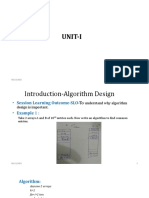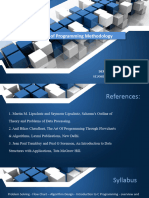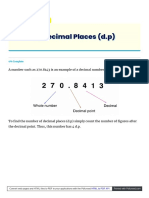Lesson Plan: Computer Programming (NET Technology) NC II
Uploaded by
Gess Jamandre MoralinaLesson Plan: Computer Programming (NET Technology) NC II
Uploaded by
Gess Jamandre MoralinaRepublic of the Philippines
Department of Education
REGION VI - WESTERN VISAYAS
SCHOOLS DIVISION OF BACOLOD CITY
I. CURRICULUM CONTENT, STANDARDS, LEARNING COMPETENCIES AND OBJECTIVES
A. Content Standards
Demonstrate an understanding of the principles and concepts in solving problems in the
workplace, including the application of problem solving techniques, and in resolving the
root cause of problems
B. Performance
The learners independently solve problems in the workplace, including the application
Standards
of problem solving techniques based on TESDA Training Regulations
C. Learning
1.1 Identify mathematical tools and techniques to solve problems
Competencies and
TLE_ICTJAVA1 1-12 MCT-Ie16
Objectives
Learning Objectives:
At the end of the lesson, the learners shall be able to:
● Identify problem areas based on the given condition
● Select mathematical techniques based on the given problem
D. Content
SOLVE PROBLEM RELATED TO WORK ACTIVITIES (PRW)
E. Subject Integration
Math: Apply mathematical concepts (e.g., calculations, measurements) in programming
tasks. programming skills, integrating knowledge from multiple subjects.
F. 21st Century Skills Problem Solving: Enabling learners to effectively navigate and resolve workplace challenges
Framework through integrated knowledge and skills.
II. TEACHING AND LEARNING RESOURCES
● https://www.tesda.gov.ph/Downloadables/TR%20-%20Programming%20(Java)%20NC%20III.pdf
● Insert or remove a page break. (n.d.). https://www.deped.gov.ph/wp
content/uploads/2019/01/Programming-.Net-Technology-NC-III-CG.pdf
● https://www.scribd.com/document/522312245/Lesson-Exemplar-Java-Programming-ENRIQUEZ-4
“Una sa tanan, BATA: Buligan, Amligan, Tudluan, Alalayan!”
Rosario–San Juan Streets, Bacolod City 6100 Telephone: (034) 704-2585
Facebook Page: https://www.facebook.com/bacolod.deped Email: bacolod.city@deped.gov.ph
Republic of the Philippines
Department of Education
REGION VI - WESTERN VISAYAS
SCHOOLS DIVISION OF BACOLOD CITY
III. TEACHING AND LEARNING PROCEDURES
A. Activating Prior Motivational Questions:
Knowledge ● How do mathematical concepts play a role in programming?
(Minds and Moods)
● Can you give an example of how you might use math to solve a problem in a
programming context?
*NOTE: Remember, every problem you encounter is an opportunity to learn and grow.
Embrace these challenges as stepping stones towards becoming a skilled programmer and
problem-solver.
B. Establishing Lesson Present the Lesson Title and Objectives.
Purpose
(Aims) Unlocking Content Area Vocabulary:
*NOTE: Remember, the skills you develop today will not only help you tackle coding tasks but
will also empower you to overcome obstacles in any area of your life.
● Algorithm: A step-by-step procedure for solving a problem or accomplishing a task
in programming.
● Debugging: The process of identifying and fixing errors or bugs in code to ensure
correct functionality.
● Data Structure: A way of organizing and storing data in a program to enable
efficient access and modification.
C. Developing and An algorithm is a systematic procedure for solving problems or performing computations,
Deepening consisting of a precise list of instructions executed step by step in hardware or software.
Understanding Commonly used in IT fields such as mathematics, computer programming, and computer
(Tasks and Thoughts) science, algorithms address recurring problems and specify data processing tasks. They can
sort numbers or handle complex functions, like content recommendations on social media.
Algorithms begin with initial input and defined instructions, ultimately producing an output
after execution.
How do algorithms work?
Algorithms work by following a set of instructions or rules to complete a task or solve a
problem. They can be expressed as natural languages, programming languages, pseudocode,
flowcharts and control tables. Natural language expressions are rare, as they are more
ambiguous. Programming languages are normally used for expressing algorithms executed
by a computer.
“Una sa tanan, BATA: Buligan, Amligan, Tudluan, Alalayan!”
Rosario–San Juan Streets, Bacolod City 6100 Telephone: (034) 704-2585
Facebook Page: https://www.facebook.com/bacolod.deped Email: bacolod.city@deped.gov.ph
Republic of the Philippines
Department of Education
REGION VI - WESTERN VISAYAS
SCHOOLS DIVISION OF BACOLOD CITY
There are several types of algorithms, all designed to accomplish different tasks:
● Search engine algorithm: This algorithm takes search strings of keywords and
operators as input, searches its associated database for relevant web pages and
returns results.
● Encryption algorithm: This computing algorithm transforms data according to
specified actions to protect it. A symmetric key algorithm, such as the Data
Encryption Standard, for example, uses the same key to encrypt and decrypt data. If
the algorithm is sufficiently sophisticated, no one lacking the key can decrypt the
data.
● Greedy algorithm: This algorithm solves optimization problems by finding the
locally optimal solution, hoping it is the optimal solution at the global level.
However, it does not guarantee the most optimal solution.
● Recursive algorithm: This algorithm calls itself repeatedly until it solves a problem.
Recursive algorithms call themselves with a smaller value every time a recursive
function is invoked.
● Backtracking algorithm: This algorithm finds a solution to a given problem in
incremental approaches and solves it one piece at a time.
● Divide-and-conquer algorithm: This common algorithm is divided into two parts.
One part divides a problem into smaller subproblems. The second part solves these
problems and then combines them to produce a solution.
● Dynamic programming algorithm: This algorithm solves problems by dividing them
into subproblems. The results are then stored to be applied to future corresponding
problems.
● Brute-force algorithm: This algorithm iterates all possible solutions to a problem
blindly, searching for one or more solutions to a function.
● Sorting algorithm: Sorting algorithms are used to rearrange data structures based
on a comparison operator, which is used to decide a new order for data.
● Hashing algorithm: This algorithm takes data and converts it into a uniform
message with a hashing.
● Randomized algorithm: This algorithm reduces running times and time-based
complexities. It uses random elements as part of its logic.
“Una sa tanan, BATA: Buligan, Amligan, Tudluan, Alalayan!”
Rosario–San Juan Streets, Bacolod City 6100 Telephone: (034) 704-2585
Facebook Page: https://www.facebook.com/bacolod.deped Email: bacolod.city@deped.gov.ph
Republic of the Philippines
Department of Education
REGION VI - WESTERN VISAYAS
SCHOOLS DIVISION OF BACOLOD CITY
*NOTE: Encourage creativity and collaboration throughout the activity. Remind
students that the goal is to learn from each other and think critically about
programming challenges they may face in real-world scenarios.
Brainstorming Activity:
● Divide Students into 4 groups, assigning each group a different programming
project scenario:
Group 1: Web Development
Group 2: Mobile App Development
Group 3: Game Development
Group 4: Software Testing
● Each group will brainstorm ideas related to their assigned scenario. Encourage
them to think about potential challenges or variances they might encounter, such as
performance issues, user experience problems, or technical limitations.
● Have each group write down all their ideas on a large sheet of paper or a digital
document. Ensure they include both the problems identified and any initial
thoughts on potential solutions.
● Each group will discuss their ideas, evaluating the feasibility and impact of each
one. They should aim to select one idea that they believe is the most practical and
has the potential for significant positive effects.
● Present Findings: Each group will prepare a brief presentation (5-7 minutes) to
share their chosen idea with the class. They should explain:
-The specific problem their idea addresses.
-How their solution works and why it is effective.
-Any anticipated challenges in implementing their solution and how they might
overcome them.
D. Making Generalization Analysis:
(Abstraction) ● How do mathematical concepts influence programming tasks?
● What is the purpose of an algorithm in programming?
● What are some common types of algorithms mentioned, and how do they function?
Abstraction:
The text emphasizes the integral role of mathematical concepts and algorithms in
programming, highlighting how structured problem-solving techniques can enhance the
effectiveness of software development and address various challenges in the workplace.
IV. EVALUATING LEARNING: FORMATIVE ASSESSMENT AND TEACHER’S REFLECTION
A. Evaluating Learning Quiz:
(Tools for Test) 1.What is an algorithm?
A) A random guess to solve a problem.
B) A systematic procedure for solving a problem or performing a computation.
C) A programming language.
D) A type of software.
“Una sa tanan, BATA: Buligan, Amligan, Tudluan, Alalayan!”
Rosario–San Juan Streets, Bacolod City 6100 Telephone: (034) 704-2585
Facebook Page: https://www.facebook.com/bacolod.deped Email: bacolod.city@deped.gov.ph
Republic of the Philippines
Department of Education
REGION VI - WESTERN VISAYAS
SCHOOLS DIVISION OF BACOLOD CITY
2.Which of the following is NOT a type of algorithm mentioned in the content?
A) Recursive algorithm
B) Dynamic algorithm
C) Greedy algorithm
D) Sorting algorithm
3.What is the primary purpose of a debugging algorithm?
A) To transform data for security.
B) To sort numbers in a list.
C) To identify and fix errors in code.
D) To recommend user content.
4.In the brainstorming activity, what is the first step each group must take?
A) Discuss their ideas.
B) Present their findings to the class.
C) Write down their ideas.
D) Select the most feasible idea.
5.How do algorithms typically produce an output?
A) By randomly generating results.
B) By following a set of instructions or rules based on initial input.
C) By using trial and error.
D) By relying on natural language input.
B. Teacher’s Reflection Note observations on any
(Annotation)
of the following areas: Effective Practices Problems Encountered
Strategies Explored
Materials Used
Learner Engagement/
Interaction
Others
C. Teacher’s Remarks Reflection Guide:
(Gains) ● Why did I teach the way I did?
● What did my students learn? How did they learn?
● What can I explore in the next lesson?
“Una sa tanan, BATA: Buligan, Amligan, Tudluan, Alalayan!”
Rosario–San Juan Streets, Bacolod City 6100 Telephone: (034) 704-2585
Facebook Page: https://www.facebook.com/bacolod.deped Email: bacolod.city@deped.gov.ph
Republic of the Philippines
Department of Education
REGION VI - WESTERN VISAYAS
SCHOOLS DIVISION OF BACOLOD CITY
“Una sa tanan, BATA: Buligan, Amligan, Tudluan, Alalayan!”
Rosario–San Juan Streets, Bacolod City 6100 Telephone: (034) 704-2585
Facebook Page: https://www.facebook.com/bacolod.deped Email: bacolod.city@deped.gov.ph
You might also like
- COMPUTER PROGRAMMING 12 - Q1 - W1-W4 - Mod1-Mod4100% (5)COMPUTER PROGRAMMING 12 - Q1 - W1-W4 - Mod1-Mod463 pages
- COMPUTER PROGRAMMING 12 - Q1 - W1 - Mod1 PDFNo ratings yetCOMPUTER PROGRAMMING 12 - Q1 - W1 - Mod1 PDF15 pages
- Department of Education: Republic of The PhilippinesNo ratings yetDepartment of Education: Republic of The Philippines2 pages
- Module 1 CS104 Data Structures and AlgorithmsNo ratings yetModule 1 CS104 Data Structures and Algorithms17 pages
- Chapter Two - Algorithms and Data StructuresNo ratings yetChapter Two - Algorithms and Data Structures57 pages
- Introduction To Ict.: (Algorithms.) Lecture # 15-16 By: M.Nadeem Akhtar. Lecturer. Department of CS & ITNo ratings yetIntroduction To Ict.: (Algorithms.) Lecture # 15-16 By: M.Nadeem Akhtar. Lecturer. Department of CS & IT59 pages
- CLASS 11 CS CH3_INTRODUCTION TO PROBLEM SOLVING_NOTESNo ratings yetCLASS 11 CS CH3_INTRODUCTION TO PROBLEM SOLVING_NOTES11 pages
- Disclaimer: College of Information and Communications TechnologyNo ratings yetDisclaimer: College of Information and Communications Technology33 pages
- Class11_Introduction to problem solving revision notesNo ratings yetClass11_Introduction to problem solving revision notes9 pages
- Lesson: 1 Class: Xi Subject: Computer Science Topic: Algorithm and Flowchart Date: 23.12.2017 Duration: 45 MinsNo ratings yetLesson: 1 Class: Xi Subject: Computer Science Topic: Algorithm and Flowchart Date: 23.12.2017 Duration: 45 Mins9 pages
- Class 11 Cs Ch5_introduction to Python and Debugging_notesNo ratings yetClass 11 Cs Ch5_introduction to Python and Debugging_notes40 pages
- BC101 Lecture 1 - Terminologies, Problem Solving & Program DesignNo ratings yetBC101 Lecture 1 - Terminologies, Problem Solving & Program Design21 pages
- Fundamentals-of-Programming-Teaching-GuideNo ratings yetFundamentals-of-Programming-Teaching-Guide4 pages
- A Comparison of Classification Techniques On Prediction of Student PerformanceNo ratings yetA Comparison of Classification Techniques On Prediction of Student Performance6 pages
- Oracle Fusion Cloud Procurement_ AI & Redwood InnovationsNo ratings yetOracle Fusion Cloud Procurement_ AI & Redwood Innovations46 pages
- Software Requirement Analysis &it's NeedsNo ratings yetSoftware Requirement Analysis &it's Needs37 pages
- NIST CSF To NERC CIP Mapping PresentationNo ratings yetNIST CSF To NERC CIP Mapping Presentation21 pages
- Relativistic Kinetic Theory With Applications In Astrophysics And Cosmology Gregory V Vereshchagin instant downloadNo ratings yetRelativistic Kinetic Theory With Applications In Astrophysics And Cosmology Gregory V Vereshchagin instant download26 pages
- Universal Design For Learning in The Early Childhood Classroom100% (1)Universal Design For Learning in The Early Childhood Classroom153 pages
- KTU_Student_MoocCourseRegistration_NASSCOM_Student_HelpNo ratings yetKTU_Student_MoocCourseRegistration_NASSCOM_Student_Help10 pages
- Gps and GSM Based Self Defense System For Women Safety 2332 0796 1000233No ratings yetGps and GSM Based Self Defense System For Women Safety 2332 0796 10002333 pages
- Design of Intze Water Tank Using Java ProgramNo ratings yetDesign of Intze Water Tank Using Java Program5 pages
- Baby Lock Ellisimo Gold BLSOG Sewing Machine Instruction ManualNo ratings yetBaby Lock Ellisimo Gold BLSOG Sewing Machine Instruction Manual9 pages
- WWW Kofastudy Com Courses jss1 Mathematics 1st Term LessonsNo ratings yetWWW Kofastudy Com Courses jss1 Mathematics 1st Term Lessons5 pages
- About Dinamica EGO: Home About Documentation Applications PublicationsNo ratings yetAbout Dinamica EGO: Home About Documentation Applications Publications3 pages
- Data - Led Approach To Digital InnovationNo ratings yetData - Led Approach To Digital Innovation11 pages
- Lecture Notes - Introduction To Information Systems (PDF) - Course SidekickNo ratings yetLecture Notes - Introduction To Information Systems (PDF) - Course Sidekick3 pages

























































































